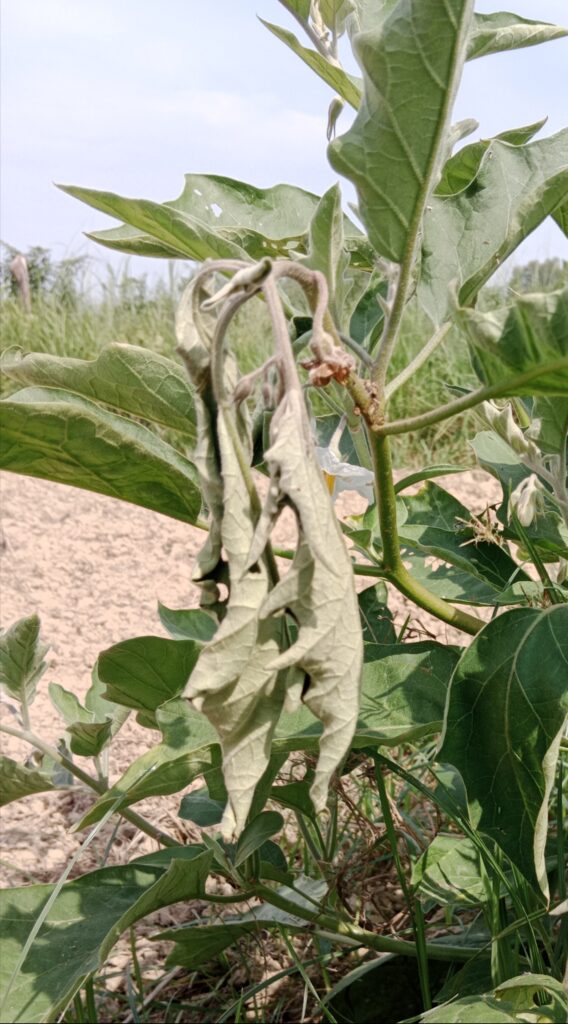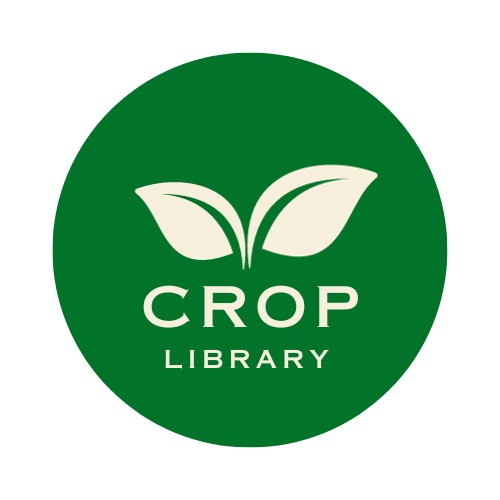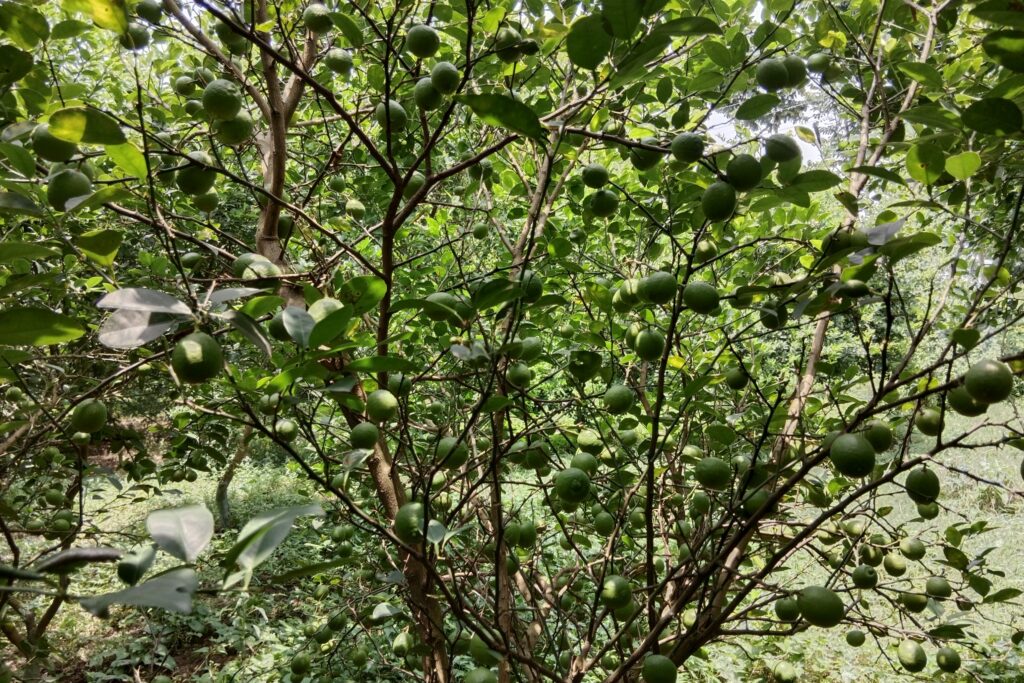Introduction
Eggplant, or brinjal, is a widely cultivated vegetable, yet it faces a major threat from the Brinjal Shoot and Fruit Borer. This pest begins infesting crops just weeks after transplantation and is one of the most damaging to eggplant yields, significantly reducing both quantity and quality. Predominantly found in South and Southeast Asia, the larvae of this pest burrows inside the fruit, rendering it unsuitable for sale or consumption.

The Brinjal Shoot and Fruit Borer can damage up to 30-50% of the crop. The pest’s life stages include white eggs, pink larvae, greyish pupae, and adults with black and brown bodies marked with white spots. Among these growth stages, larval stage is most dangerous. The effective management of this pest is crucial for farmers to produce healthy, marketable eggplants. Brinjal shoot and fruit borer management strategies are given below:
SIMILAR POST: Causes of Tomato Fruit Crop
Symptoms of Brinjal Shoot and Fruit Borer Infestation
The caterpillars penetrate the stems or petioles of large leaves, consuming the plant’s internal tissues. This damage causes affected stems to wither, resulting in drooping symptoms. Once fruit formation begins, the caterpillars enter beneath the calyx and then burrow into the fruit. They seal entry holes with excreta, making infestation hard to detect. Visible signs appear only as large exit holes left on the fruit. Symptoms of infestation appear as:
- Wilting and drying of terminal shoots caused by larval tunneling.
- Noticeable holes in stems or fruits.
- High flowers drop due to larvae damaging flower buds.
- Brownish excreta near boreholes, signaling larval activity.
Host range
Brinjal, potato, various wild Solanaceae plants, and peas.
Management Strategies for Brinjal Shoot and Fruit Borer.
Effectively managing the brinjal shoot and fruit borer requires an integrated approach, utilizing cultural, biological, and chemical methods to control pest populations sustainably. Here are some effective management strategies:
Cultural Control Methods
- Removing terminal leaves with boreholes is an effective preventive measure to reduce pest infestation.
- Crop Rotation: Plant non-host crops in alternate seasons to disrupt the pest lifecycle, avoiding continuous eggplant cultivation.
- Trap Cropping: Plant a small area of eggplant early to attract and concentrate pests, then eliminate any infested plants.
- Proper Spacing: Avoid dense planting to improve airflow and lower humidity, making conditions less favorable for pests.
- Timely Harvesting: Harvest fruits regularly to reduce breeding sites for larvae.
- In endemic areas, opt for long and narrow eggplant varieties.
- Remove terminal shoots that show signs of boreholes.
- Remove and destroy affected fruits.
Biological Control
Predatory Insects
- Introduce beneficial insects like Trichogramma chilonis, a parasitic wasp that targets shoot and fruit borer eggs, helping reduce pest populations.
- Release egg parasitoids Trichogramma chilonis at a rate of 1.0 lakh/ha.
- Promote the activity of larval parasitoids like Pristomerus testaceus and Cremastus flavoorbitalis.
Bacillus thuringiensis (Bt) Spray
- Bt, a natural soil bacterium, is toxic to Brinjal shoot and fruit borer larvae but safe for humans and beneficial insects. Apply it at recommended intervals for effective pest control.
- Use Bacillus thuringiensis at a rate of 1.5 to 2 ml per liter of water.
Mechanical Control
Hand-Picking Larvae
- Regularly inspect plants and manually remove larvae to prevent infestation from spreading.
Use Traps
- Set up light traps at a rate of 1 per hectare to attract and capture adult moths, reducing the breeding population.
- Install pheromone traps at a rate of 12 per hectare.
Sanitation
- Clear crop residue after each season to remove any pupae and prevent breeding grounds for the next generation.
Uproot and Burn Old Plants
- Remove and burn older plants before replanting to eliminate pests and prevent carry-over of infestation.
Chemical Control
Insecticide Application
Begin insecticidal treatments one month after transplanting.
Timing of Spraying:
Apply insecticides in the early morning to avoid the midday heat.
High Pest Pressure:
When pest levels are high, use insecticides specifically targeting EFSB larvae, like neem-based products or those with low environmental impact.
Insecticide Rotation:
Rotate between insecticide classes to prevent resistance and minimize overuse.
Avoid During Harvest:
Do not apply insecticides at the time of fruit maturation or during harvest.
Application Schedule:
Apply one insecticide starting one month after planting, with applications every 15 days.
Effective Insecticides
- Emamectin benzoates 25 WG at 0.4 gm/lit starting one month after planting at an interval of 15 days.
- Dimethoate 30% EC at 7.0 ml per 10 liters.
- Quinalphos 25 EC at 1.5 L per hectare.
Neem Extract:
- Spray 5% Neem Seed Kernel Extract or one of the above chemicals starting one month after planting at intervals of 15 days.
Spray Spinosad 45 SC at 0.5 ml/lit. starting one month after planting at an interval of 15 days.
Spray Azadirachtin0% EC at 3.0 ml/lit in 500–750 lit. water per hectare.
Avoid Synthetic Pyrethroids: Refrain from using synthetic pyrethroids, as they can cause a resurgence of sucking pests.
Monitoring and Integrated Pest Management (IPM)
Regular Monitoring
Closely observe the crop for any signs of infestation, as early intervention is essential for effective control.
Integrated Pest Management (IPM)
Use a combination of cultural, biological, mechanical, and chemical methods to create a sustainable pest management plan and reduce environmental impact.
Life Cycle of Brinjal Shoot and Fruit Borer
The brinjal shoot and fruit borer is a significant pest affecting eggplant crops, and its lifecycle consists of several distinct stages. The adult moth lays around 150 to 350 creamy white eggs on various parts of the plant, including leaves, tender shoots, flowers, and developing fruits. After an incubation period of 3-4 days, the eggs hatch into stout, pink larvae, which have sparse hairs and a brownish head.
These larvae go through five instars over a 15-day larval period, boring into the shoots and fruits, ultimately weakening the plant and causing significant direct damage. Once they reach maturity, the larvae pupate in tough, grayish boat-shaped cocoons attached to the plant itself, with the pupal stage lasting 6-8 days. Overall, the complete lifecycle of the brinjal shoot and fruit borer can range from 17 to 50 days, depending on environmental conditions.
The damage inflicted by the brinjal shoot and fruit borer are typically rendered unmarketable, while infested shoots lead to stunted plant growth, negatively impacting overall yield. Female moths lay eggs individually or in clusters on the undersides of leaves, stems, flower buds, or the base of fruit, with larvae emerging after 3-5 days.
These larvae quickly bore into the fruits, causing significant harm. After feeding, they pupate in a gray cocoon woven on stems, dried shoots, or among fallen leaves, lasting 6-8 days before adults emerge. Adult moths have a short lifespan of two to five days, completing their lifecycle in 23 to 43 days, with up to five overlapping generations possible each year. During winter, larvae hibernate in the soil, and this pest also feeds on other solanaceous plants, including tomatoes and potatoes.



Pingback: How to Control Wilt in Brinjal? 6 Best Tips. -